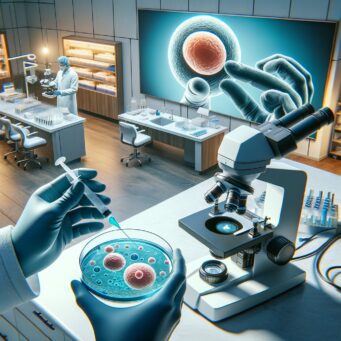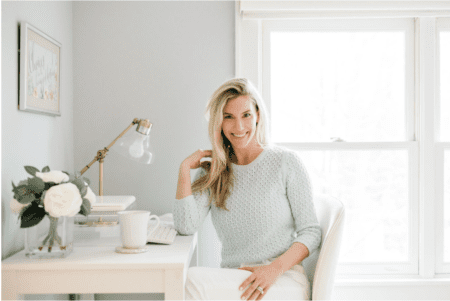
I am a social psychologist. I research the science of motivation and goal setting, but little did I know that I’d become my own worst test case once my husband and I tried to have a baby.
My story is sad, and gross in parts, but has a happyish ending. We ultimately learned to give in, without having to give up our goal, our dream of a family.
I’ve actually been pregnant a few times, and I started with science, in a way. There are a lot of apps that people who are fortunate enough to be pregnant use to get a sense of how big their baby is throughout the 40-week incubation. Maybe you’ve seen them? They say things like this: At 4 weeks, a baby is the size of a poppy seed. At 16 weeks, a baby is the size of a large avocado. By 30 weeks, a cucumber. (I guess the app makers know that a baby seems to get a pair of sneakers in utero and burns off all the chub, turning it into a long, thin kicking machine).
I have used those apps off and on in my life. Each time, though, somewhere along the line, I lost the babies. But before each of those losses, I found those apps oddly addictive. I never wanted to grow vegetables inside me, but perhaps being a scientist, I was fascinated with tracking what my garden had produced.
I first tried getting pregnant at what was the “right” time in my job, according to the old-guard in my field. I’d been studying in university for a long time, and had clocked about a decade in my career before I even started thinking about babies. All of this meant that when I tried for real, I was, medically speaking, “old.”
Meanwhile, my colleagues were getting serious about their secret mission to get me fired. If they won this battle I would be out of a job, and my odds of landing another permanent gig slim to none. It was the most stressful time of my career, and the only thing I could do was wait for the decision.
My husband, Pete, offered a plan for distraction. “Let’s just leave. Let’s get on a plane and find the most remote place we can get to next week, and let this play out on its back home.”
We booked a car to take us to the airport, a flight to get us out of the country, a puddle jumper prop plane to fly us far into the Caribbean sea to an almost uninhabited island, and found a golf cart to take us to the only hotel on the island. We walked for two miles that first afternoon on the beach. We saw no one else. No other homes. No cars. Just us. Just like we wanted.
Then I noticed the spots. See, I was 12 weeks pregnant. Exactly 12 weeks the day we landed on this remote stretch of land. No one but the doctor and the two of us knew. After the walk, there were eensy spots on the lining of my panties. Not red, not blood looking. But not normal. Or was it normal? I didn’t know. I tried calling my doctor, but our phones didn’t work. I tried finding a wifi signal but there weren’t any. We couldn’t call internationally from the hotel, but somehow someone relayed a message back to New York, to my doctor in particular that I needed her to call me. I waited. And waited. I hoped she could get through. As I waited the spots got bigger, and so did my fear.
I couldn’t make calls out. I could only answer the phone when it rang in, and it always seemed to ring just once before going to voicemail. That single ring seemed to only come through when we were standing in the hotel parking lot. A few times, I could hear my doctor say on the line, “Emily are you there? I heard it was an emergen…” before the call would drop again. We had wanted the remoteness of this location when we were back in New York, but absolutely hated it as we waited for hours in that parking lot.
I eventually connected with my doctor, and she started by asking, “Is it the size of a lemon?” A lemon, I wondered. What is she talking about? Like what piece of fruit is this 12-week fetus supposed to look like? Why does she care and doesn’t she know?
“No, Emily. Is what you are seeing in the toilet and in your underwear the size of a lemon?” She explained that I might be hemorrhaging. That I could go into shock. That the baby might be dying, probably was dying. More than that, I could be, too. “Promise me, Emily,” she said, “that if it’s the size of a lemon, you’ll find a way to get to an emergency room.”
For the next five days, I was in labor. Of sorts. My lower back ached, and clenching spasms would roll from one side of my spine to the other every five or six minutes. The pain in my belly pushed back through to my sacrum and with each wave the throbbing would compound on itself.
At one point, my husband found me lying on the floor, cheek pressed against cold tile, curling up around myself, then uncoiling my limbs trying to find a position that didn’t hurt as much. I could barely keep my eyes open. He said I moaned with a constant, low-pitched drone, but I don’t remember doing that because I was only half conscious. We left for the hospital.
The doctors and nurses in the hospital spoke English but with an accent so different than mine that I caught little of what they were telling me. A needle went into my arm and I still don’t know what they put in me. The ultrasound technician spent a long time staring at the screen and repositioning the wand. She said under her breath “not good” and left the room with the last image burning into the monitor. We saw the silhouetted white outlined contours of what was in my uterus.
While we waited, I kept saying, “The baby is dead. This isn’t right. Something’s not right. The baby is dead.” My husband kept saying, “We don’t know. She didn’t say that. It can still be fine. It can be.” That might have been one of the most powerfully diagnostic personality tests either of us had ever faced. He, the hopeful optimist in denial. Me, the pessimistic realist.
The nurse returned with a doctor. We learned that there was no heartbeat. The fetus was sitting just above my cervix which was now open. “Lay down for a few days until the miscarriage happens.” That’s how we learned we had lost the baby.
I felt two more days of rolling spasms and fear. I don’t know why they sent me back to the hotel, but they did say to return to the ER whenever I felt I needed it. That was terrifying; I have a PhD, not an MD. I’m far from the kind of doctor who would know when the time was right. In fact, the amount of tissue I was passing was shocking, at least to me and I was the only person seeing it. I didn’t show Pete. He was still thinking a miracle of rebirth would be possible. Was it the size of a lemon? I don’t know. It didn’t come out shaped like a sphere. I asked myself, if I smooshed what I saw into that form, would it be as big? It was close.
I laid on a beach chair under a palm tree, watching the waves in the ocean roll in and noticed how my waves of pain and sadness matched the undulations of the sea.
My husband and I sat next to each other, suffering from the doctor’s news in our own unique ways, alone. We found little comfort in each other’s approach. He continued to hope, clenching on to the last all but illusory threads of possibility, and getting mad that I couldn’t grasp any myself. His anger grew, but that was only masking a sadness he wasn’t ready to admit. I had braced myself for the imminent impact with rock bottom, and feeling so alone in my fall. My resentments mounted. In my head, I was certain that only I was bearing the psychological burden of a lost life.
In the few days that followed, Pete and I still had a few more trials of marriage to get through. As he cooled off in the surf, he lost his wedding ring which hadn’t yet dulled or scuffed with age. We never found it. I figured out how to call my parents through social media, and through the static and in bits and pieces as the call kept dropping, I told them that I was pregnant. Was pregnant, but now I’m not—and I think my marriage won’t survive this. All of this was news.
After two days, I woke up early. I felt something slip between my legs. I had just crossed the threshold into the bathroom when masses of tissue fell from my body and splattered on the floor. I sat on the toilet and the rest landed there. I saw a distinctly recognizable form in the water and screamed. I slammed the door, locked it, and yelled at Pete to leave me alone. Years later I still don’t know why I needed to collect and clean it up from the floor myself. Saving Pete from seeing what terrified me? Or shutting him out to hold it against him later on? Probably both.
The ultrasound technician spent a long time staring at the screen and repositioning the wand. She said under her breath ‘not good’ and left the room with the last image burning into the monitor. We saw the silhouetted white outlined contours of what was in my uterus.
We never found out why we lost the baby. But I did find out something about myself that I will and have taken with me, as we approached the next phases of our journey in trying to have children. What I learned is the value of giving in, allowing myself to accept what was and make a new path.
As an expert in the study of motivation, I know that disengaging from a goal is a critical stage in the process of accomplishing what we set our sights on. But as a normal human, I also know that it’s an ugly thing to consider. Giving up seems like failure. The possibility of accepting that we won’t get what we want, what we’ve worked so hard to achieve is unthinkable. But we weren’t ready yet to deal with all of this. What did the research say?
Researcher Carsten Wrosch, at Concordia University in Montreal, spent his career investigating whether disengaging from goals proves more advantageous for individuals than the continued chase of unattainable outcomes. He discovered that adults who suffered the blows of divorce actually were happier than they anticipated they would be, and were happier than were other divorcees, when they reconsidered how they would find happiness and social connection.
Wrosch found that if they spent the year and a half that followed their separation by continuing to chase the exact life that they had lost, their mental health and well-being suffered. But those who took a step back and reconsidered the multitude of paths they could take to create a full life, they reported having more satisfying and stable emotional lives. The approach that yielded the biggest return was the one that had them moving furthest from their original plan for happiness.
After Pete and I got back to New York, we took a few months to recover emotionally and physically. We lived in a one-bedroom Manhattan apartment that had less square footage than most suburban garages. But we still managed to give each other a very wide berth. I avoided seeing him, and I suspect he did the same.
I was angry at my body for giving me something to covet, to eagerly anticipate, then taking it away from me. I was angry at myself for getting sucked in too early to the joy of motherhood. I was angry at Pete for taking a path different than the one I was on towards recovery, though I realize that I too chose to point myself in a direction he didn’t want to follow. And all that burning anger needed to smother itself out.
And it did. For me, it happened mostly by waiting for the feelings to settle. Pete and I found each other and our strong marriage again, but first we had to get past hundreds of passive-aggressive moments. We each rebuked dozens of olive branches that one of us tried to pass to the other. After a month or two, we had one very, very hard conversation, where we really listened to what each other went through on that island. And we said to each other “I’m sorry,” and meant it.
After six months, we started trying to get pregnant again. This time, though, we entertained a host of options for medical assistance. We had never thought before this point that we would need them. Didn’t think before that we would want them. But this was literally uncharted territory for us.
I started by topping off my Vitamin D reserves—the skyscrapers rarely let sun rays fall on any New Yorker’s skin, and some doctors thought it might be part of the problem. They were right about my deficiency, but wrong that is was the source of my infertility. On medical advice, I tried diabetes medications despite always having blood sugar levels within the normal range.
Then we added the fertility cocktails that paved the way for several rounds of IUI. I started polka-dotting my stomach with needle pricks and bruises. For half of each month, I spent every other pre-dawn morning in a walk-in clinic waiting my turn for a blood draw and photoshoot for my ovaries. I coordinated my work trips with Pete’s so our eggs and sperm were in the same time zone as our doctors for the maximal moment of opportunity and impact.
None of it worked. But we learned a lot about our bodies and what happens when the two of us try to create someone new. Together, our DNA collectively weaves a new pattern that wouldn’t be expected by either of our profiles alone. We heard our case and the years of struggle we experienced before and after our time in the Caribbean described as rare, unique, and interesting from some of the most specialized reproductive and genetic experts. Wanting instead to just be usual and obvious, none of those words are ones we hoped to hear.
About four months in, a doctor told me my body needed a break. We needed more time to see if what looked like calcified follicles would pose a lasting problem. Come back in a month and we’ll assess, maybe start over again. But in that month hiatus, I got pregnant, in what is referred to as the “natural” way, but I beg to differ. The assistance we received to get to this moment certainly didn’t leave me feeling all too natural, and I was totally fine with that feeling, just not the term used to describe this conception.
Some theories offer that these scientific interventions prepped my body and left some residue that paved the way. As a scientist, I am trained to look for evidence of causality. Because all I have here is a single anecdote, I have no data to offer that speak to that hypothesis. So, what I’m left with as an explanation for our success is luck.
The other thing about being a scientist is that I had to cultivate patience. Experiments take years to design, conduct, and analyze. Answers to big questions don’t come quickly. You have to wait. And after all that waiting, you might find out that you were wrong or no better informed than you were when you started. That means for much of my professional life, I live with uncertainty and a nagging question of whether it was worth it.
I realized that I’d have to take some of that patience and apply here to my personal life.
Fertility and science aren’t the only endeavors that require patience. They aren’t the only ones where we might find ourselves asking if it’s worth it to push on. The same thing applies to marathons. Even if we’re not running twenty-six miles, the race to parenthood is just as grueling (and takes much longer). And there might be a lesson learned by exploring these athletes’ thoughts.
Researchers from the University of Zurich and the University of Bern analyzed the things marathoners say to themselves before, during, and after hitting the wall. That’s the physically toughest part of the race where energy reserves are depleted but the finish line is still far off. They found that at this 18-mile mark, runners’ minds swarmed with thoughts about both the pros of running farther on but also of stopping sooner. The 18-mile mark was also the point at which dropout rates were the highest. The take away here is this: if we found ourselves entertaining both the pros and cons of striving forward—when our mental flip-flopping reaches its peak—this might be the moment were we are most likely to look for new direction.
But what this study also showed was that runners who made it past this mark—who overcame the allure of throwing in the towel—were far more likely to finish the race. Dropout rates were remarkably low in the last third of the race and continued to drop lower with the passing of every few miles, even as runners had little left to give to the sport. Once we conquer the wall, the odds tip back in our favor.
We never found out why we lost the baby. But I did find out something about myself that I will and have taken with me, as we approached the next phases of our journey in trying to have children. What I learned is the value of giving in, allowing myself to accept what was and make a new path.
All together, what we learned through this process was that we had many options previously unknown to us before we started on this journey towards parenthood together. We were pulled towards giving up but instead found ourselves giving in to these new options. Knowing that they were available and trying them on for size was empowering. It was only because circumstances forced us to accept that our original plan for pregnancy was not viable, that we gave these options a shot. We tried lots of them in the months and years that surround our story. But first, we had to give up on our first plan to actually move forward, and we’ve decided together each step of the way.
And we did move forward—together. We now have a three and a half-year-old son, a healthy marriage and a strong friendship, a new goal, motivation, and a team of doctors that are helping us to try again.
Contributor
Emily Balcetis
Emily Balcetis is an Associate Professor of Psychology at New York University and the author of Clearer, Closer, Better: How Successful People See the World. Her research on effective strategies for motivation appears in more than 60 scientific publications. Her TED talk has been viewed over 3.5 million times. She lives with her husband and son in New York City.

Listen to stories, share your own, and get feedback from the community.


















